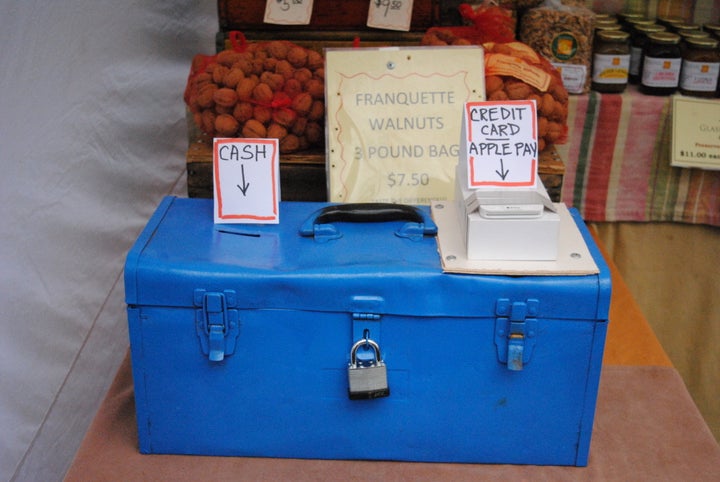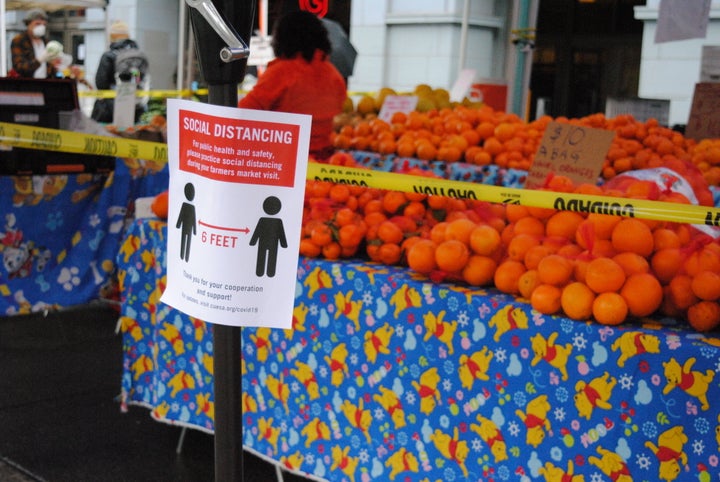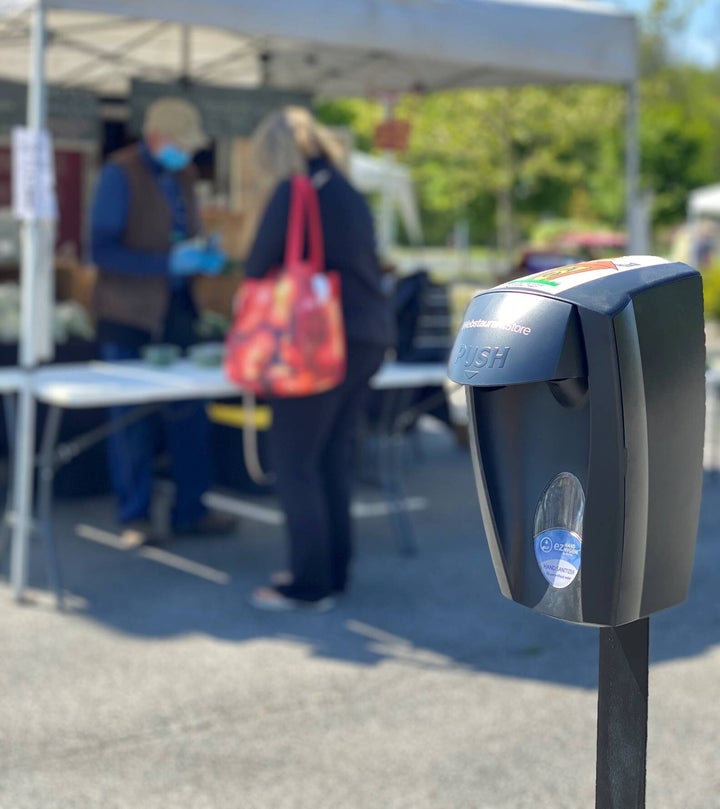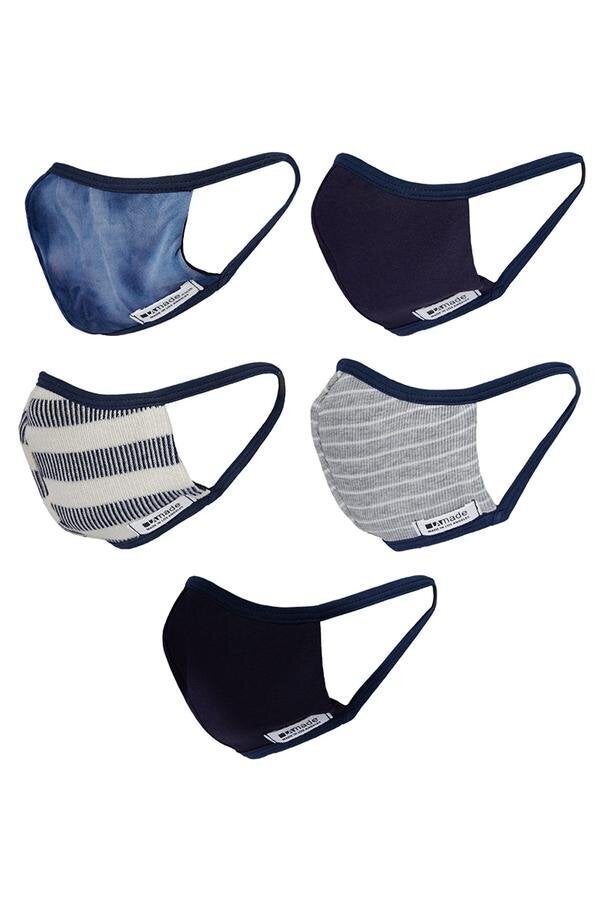As the growing season gets underway across the country, farmers markets are beginning to reopen. But because of the coronavirus pandemic, the farmers markets of 2020 are vastly different entities than farmers markets of 2019.
“Think of what you picture as a farmers market,” said Kelly Crane, executive director of the Oregon Farmers Markets Association. “Crowds, kids’ activities and music with everybody talking, interacting and hugging their neighbors ... that’s not what the markets are going to be like this season.”
We’ll also lose out on cooking demonstrations, samples of fresh produce, and milling about and sitting at tables to eat freshly prepared foods.

Just about every farmers market that’s already open or opening has new protocols and safety measures in place. Booths are farther apart to better accommodate social distancing. Farmers wear masks and gloves, and shoppers are either encouraged or required to wear masks. New signage sometimes directs shoppers to travel in one direction through a market or to keep six feet apart from each other. And some, like the Racine Farmers Market in Racine, Wisconsin, are not opening at all.
“Sampling was one of the first things we had to get rid of,” said Brie Mazurek, communications director for the Center for Urban Education About Sustainable Agriculture, which runs the Ferry Plaza Farmers Market and five other farmers markets in San Francisco.
Also, unlike grocery stores, where you can still pick up an avocado or a grapefruit to see if it’s ripe enough, there’s no touching. “You can’t handle the produce anymore,” Mazurek told HuffPost. “You have to point, and the farmers will hand you what you want to buy.”
“It’s, ‘I would like these tomatoes over there,’ and they’ll give the bag to you,” said Ariana Torres, assistant professor of the department of horticulture and agricultural economics at Purdue University ― and also an economist and a farmer. “I remember the experience of shopping when I’ve traveled to developing countries – it’s that kind of transaction.”
“If we consider the set-up of a grocery store versus a farmers market, I believe farmers markets can be more secure.”
Some markets may also be smaller. “Some are only selling produce,” Torres said. “You’re not going to see anyone selling woodwork or candles or dog treats or jewelry.”
Like grocery stores, many markets have special hours for elderly and immunocompromised customers, and volunteers and workers are trained to correct customers when they don’t stay a safe distance apart.
Many markets are also encouraging cashless payment systems, and some are even offering pickup and curbside delivery.

But unlike most grocery stores, most farmers markets have hand-washing stations with soap and water set up prominently. And while grocery stores have some hand sanitizers at the entrances, many farmers markets have numerous hand sanitizer dispensers throughout.
“If we consider the set-up of a grocery store versus a farmers market, I believe farmers markets can be more secure,” Torres said. “They’re outdoors, and since many have reduced the number of vendors, there’s better than six feet social distancing. They’re also following all of the local and state guidelines, so I believe it’s safer.”
“When farmers markets are done right, they can be as safe or safer than any indoor grocery shopping experience,” Crane said. “Farmers markets have radically changed their operations. Blown-up footprints, spaced six to 10 feet apart, lots of environmental signage and messaging before, during and after, with chalk marks or tape on the ground, plus extra perimeter control so you don’t get overloaded with density.”
“[The farmers market is] also safer because it’s a very short supply chain, and the food is not going through very many hands,” said Lauren Gwin, extension community food systems specialist at Oregon State University.

Sarah Marcus, owner of Briar Rose Creamery in Dundee, Oregon, and a vendor at four farmers markets, said she and other farmers have a hand-washing station set up as part of her booths, as well as hand sanitizer. “It’s a lot of wiping down,” she said. “What was already a clean environment is even cleaner.”
But not all farmers markets are created equal. Sheana Davis, owner of The Epicurean Connection in Sonoma, California, said she will only shop for ingredients for her catering business at one of two farmers markets in her town.
“The City of Sonoma Farmers Market moved it off of the plaza to these baseball fields in town, and they spread it out so there’s four times the amount of space for each vendor,” Davis said. “They took a really proactive approach, and they removed any merchants that weren’t agriculture-direct. It’s clear that social distancing is a priority. But when I went to another one, I said, ‘Hell, no.’ There wasn’t social distancing, and there didn’t seem to be any protocols in place.”

Marcus said that at the local Oregon farmers markets where she sells cheese, only one person per family is supposed to shop, and there’s no lingering or sampling. “Things are continuing to evolve at the markets themselves,” she said. “Now it’s more of a service and less of an event.”
“It is a different experience,” Gwin said. “The people who were just going down there to buy a pint of strawberries and just hang out in the sun … they’re probably not going this year, but the vast majority of customers who do significant shopping are going to still go. I’m really hoping that the demand is strong enough that these farmers are going to make it through.”
Marcus says farmers markets, where she always sells some cheese, keep her small creamery and its four employees in business as her restaurant and winery sales dry up. “Yes, things will improve,” Marcus said. “When? Likely next year. But I honestly don’t know.”
How to shop safely at a farmers market
Crane offers these tips to shoppers at farmers markets:
Make it speedy, she said. “Get in and get out. That helps with markets controlling the density of customers. Think about what you want ahead of time, and if they have an online preorder option, use it.”
Bring lots of small bills or use non-cash payment systems if available.
Bring your own hand sanitizer and wear a mask.
Bring your reusable bag, but it’s safer for you if you can throw it into a washing machine. “Some of the swag bags you get at conferences are synthetic, and they don’t hold up in the wash,” Crane said.
Go online to your farmers market website or Facebook page to familiarize yourself with the rules are ahead of time so you know what to expect. “It will be different,” she said.
Designate one shopper. “Don’t take your kids, and keep in mind by doing this, that market will be able to survive, to stay in business so that next year it will be able to be there for you and your kids and pets,” she said.
